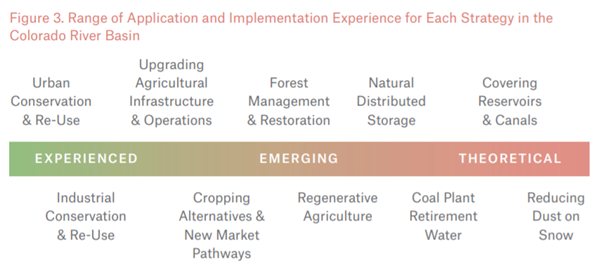August 12, 2021
Artwork by Hundred Storms Creative
The Colorado River is over-tapped and drying out. Climate change, a multi-decade megadrought, and demand that continues to outpace supply are coming to a head as the river shrinks and the largest reservoirs that provide water to 40 million Westerners reach record lows.
The challenges we face to protect the mighty Colorado River are monumental, but not insurmountable. Ensuring the long-term health of this vital waterway will require an honest look at the problem, as well as exploration and investment in long-term, innovative solutions, from those that are proven to those that are emerging or more theoretical. That is where a new report comes in, authored by Martin & McCoy and Culp & Kelly, LLP with contributions from WRA and a number of our partners: Ten Strategies for Climate Resilience In the Colorado River Basin.
The “Ten Strategies” report offers a path to increase water-related climate resilience and seeks to spark action towards proactive, coordinated, and results-oriented watershed scale projects. Through its ten strategies, the report seeks to shift the focus from managing water supply and demand within the context of drought to implementation of measures that address the risks of climate change throughout the Colorado River Basin.
Ten Strategies and What They Entail
Prioritize forest management and restoration to maintain system functionality and biodiversity. Well managed forests provide numerous benefits, from regulating snow melt and water supply to improving water quality and benefiting wildlife habitat and fisheries.
Restore degraded natural meadow systems to improve local aquifer recharge and water retention, reconnect historic floodplains, and support productive meadows and riparian ecosystems. Natural distributed storage projects are generally designed to produce environmental benefits, such as streamflow timing changes that are beneficial to watershed health, fish and wildlife habitat or migration corridor restoration, or riparian or wetland restoration and improvement.
Promote voluntary farming and ranching principles and practices that enrich soils, enhance biodiversity, restore watershed health, and improve overall ecosystem function and community health. Regenerative agriculture focuses on restoring and improving soil health biodiversity and offers an opportunity to enhance resilience in the Colorado River Basin.
Upgrade diversion, delivery, and on-farm infrastructure and operations, including irrigation systems. This may reduce pressure on existing water supplies by making operations more efficient and potentially reducing consumptive use of water, which could help agriculture in the Basin become more resilient to the effects of climate change, such as reduced streamflow.
Develop voluntary on-farm operational shifts, as well as market and supply chain interventions, to incentivize water conservation, e.g., shifting to lower water-use crops. Investments in alternative crops and creation of new pathways for farmers to access high-value markets could help reduce pressure on existing water supplies and generate resilience benefits.
- Incentivize conservation technologies, indoor and outdoor conservation programs, and direct and indirect potable reuse.
- WRA has worked for decades to boost urban and municipal water conservation and expand water reuse. Water conservation and improving efficiency are some of the best tools at our disposal to maximize existing water resources to meet communities’ needs while keeping more water in rivers.
- Over the years, many large cities have decreased water use despite serving more customers. As Western urban areas continue to grow and climate change further reduces water supplies in the Colorado River Basin, water conservation and reuse will be essential to reduce demands on rivers, reservoirs, and ecosystems. As the Ten Strategies report specifies, while urban water use “comprises only about 15% of the total Colorado River water use, it is the fastest growing water demand sector in the Colorado River Basin.”
- Stretching limited water supplies through reuse of water and conservation is important to securing a reliable water future for us all. To protect the Colorado River now and into the future, the region must incentivize conservation technologies, indoor and outdoor conservation programs, and direct and indirect potable reuse.
Incentivize modifications and upgrades to reduce water use and increase energy efficiencies. Industrial water use in the Basin includes power plant cooling, mining, snow making, data centers, and other industry processes. By changing practices and modifying or updating equipment to reduce water use and increase energy efficiencies, industries can generate significant water and energy savings, and lead the way in promoting responsible water management efforts in the Basin.
- Purchase, lease, or otherwise reallocate water rights from closed or retiring coal plants to be used for system or environmental benefits, or other uses.
- A true nexus of WRA’s Clean Energy and Healthy Rivers programs is using water from retiring Western coal plants to benefit nearby rivers, streams, ecosystems, and communities. Thanks to in large part to WRA’s 30 years of leadership in decarbonizing the power sector, Colorado is now on track to retire all but one of its coal-fired power plants by 2030. These retirements will unlock close to 100,000 acre-feet of water and present the Colorado River Basin with a unique opportunity to change the use of those water rights to satisfy multiple needs, including greater flow in rivers to support recreation, ecosystems, and habitat for fish and wildlife.
- Retiring coal plants and freeing up water for other uses can reduce greenhouse gas emissions while helping the Basin reduce pressure on its our already stressed rivers and water supplies. For example, in western Colorado, Craig Station rights could provide instream flows for the Yampa River downstream of Craig and benefit both fish species and seasonal flows. The water may also be used for bolstering system resilience by, for example, increasing reservoir storage.
- Importantly, just transition funds could be required to avoid adverse local impacts in communities dependent on coal or coal-fired power plants.
- Improve land management practices to reduce the dust on snow effect—which controls the pace of spring snowmelt that feeds the headwaters of the Colorado River.
- Restoring the degraded and drought prone arid lands primarily in Nevada, Utah, and Arizona that generate dust will be key in reducing dust on snow, as will improving forest management.
Implement solutions to reduce evaporation from reservoirs and conveyance systems. A significant amount of water in the Colorado River Basin is lost each year through evaporation from storage and conveyance infrastructure, and this will likely get worse as the region continues to warm due to climate. Covering reservoirs and canals, while more conceptual, could reduce evaporation of water supplies throughout the Basin, thereby improving efficiency, reducing pressure on existing supplies, and resulting in more water supply availability.
We can protect the Colorado River Basin for future generations of Westerners, but we need to take a holistic look at the challenges climate change will bring, and the broader solutions our region should explore, deploy, and scale. Further investigating and pursuing the measures outlined in the Ten Strategies report will improve our region’s ability to adapt to climate change while also managing water scarcity, ensuring healthy rivers, strengthening economic resilience in the face of uncertainty and change, and where possible, contributing to climate change mitigation.




